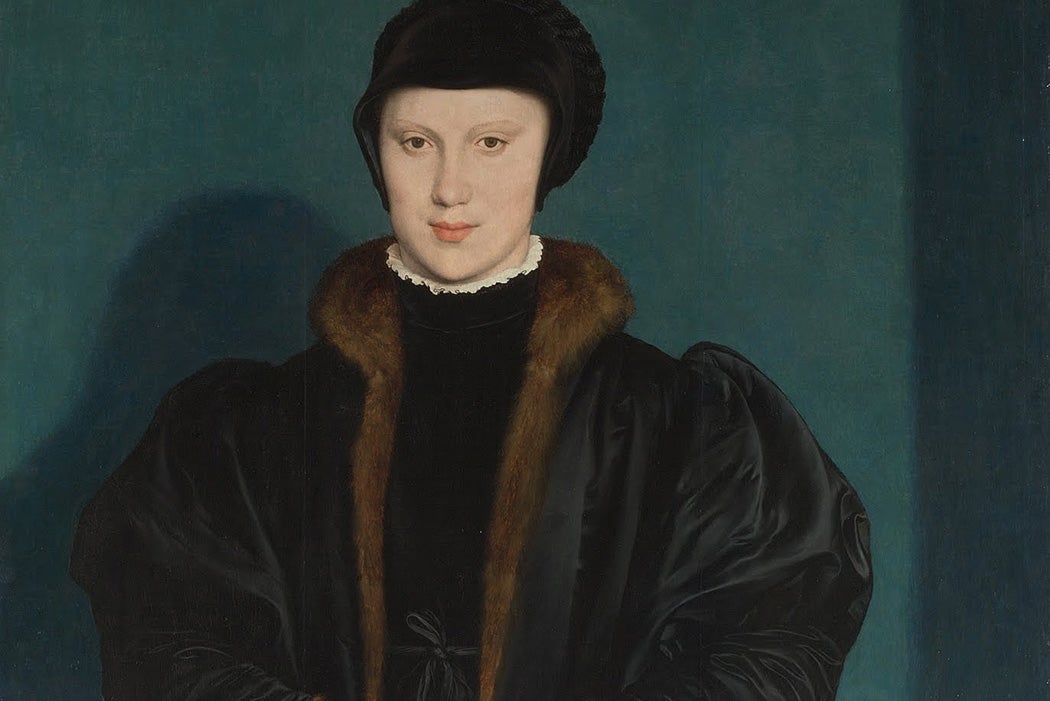The year was 1538, and King Henry VIII of England was back in the marriage market. His third wife, Jane Seymour, had died in childbirth a year earlier, leaving an opening for wife number four. Henry liked to shop around before he made a purchase, so off went his court painter, the German-Swiss talent Hans Holbein the Younger, to Milan with a mission: to paint and deliver a portrait of the famous beauty, Christina of Denmark, sixteen-year-old widow of the Duke of Milan, on whom Henry had set his sights.
According to art historian Katherine M. Poole, Holbein’s commissioned portrait of Christina was a triumph in artistic skill and royal portraiture. Holbein understood his assignment, which was to depict the formidable Christina in her widow’s mourning clothes, accurately, respectfully, but attractively. Drawing on the scholarship of Christiane Hertel, Poole suggests that Christina played “a significant role in shaping the image presented to the king,” more so than either patron or painter.
While Henry was impressed with Christina, she was far less than enthralled with her suitor. Henry’s track record with women was nightmarish, a stomach-churning prospect for any single woman. His first wife, Catherine of Aragon, had been Christina’s great aunt, of whom Henry had legally disposed when she couldn’t give him a son. His second wife, Anne Boleyn, was beheaded when she failed at the very same task. And poor Jane Seymour? She had given him a son but was so physically weak that childbed fever had carried her away. Legend had it that, when asked if she would be willing to marry Henry, Christina responded, “If I had two heads, one should be at the King of England’s disposal.”
Christina’s declaration constituted what would be known today as a “sick burn.” However, in her time, it was an act of brilliant political manipulation. With her cleverly chosen words, she didn’t outright reject Henry and invite his ire on herself and her powerful family, but she made it clear that she didn’t approve of his marital trespasses nor did she think a union between them would lead to happiness.
Weekly Newsletter
Christina’s family, who collectively disapproved of Henry for his mistreatment of Catherine of Aragon, heard and listened. The match was, ultimately and thankfully, rejected. Christina was instead wed to the less threatening Francis I, Duke of Lorraine, and with him enjoyed a fairly harmonious marriage. The best Henry himself could swing was Anne of Cleves, the sister of the Duke of Cleves. That marriage ended in a divorce after six months of mutual dislike and no consummation. Ironically, Anne of Cleves and Francis I were betrothed to each other at one point. Henry and Christina basically swapped fiancé(e)s.
Today, Holbein’s full-length portrait of Christina, narrowly saved from Henry’s clutches, can be gazed upon in the National Gallery in London. As art historian Elizabeth Goldring documents, the painting passed between several hands in the country of Christina’s would-be husband. Holbein himself, after painting her picture for Henry’s benefit, must have privately wondered how long her head would have sat on her shoulders, should she have accepted Henry’s proposal.
Three Tips for Teaching:
Incorporate video sources: The National Gallery has shared two videos featuring Holbein’s portrait of Christina: a one-minute quick look and a thirty-minute gallery talk. The Morgan Library & Museum has also shared a video based on the 2022 exhibition Holbein: Capturing Character.
Examine more paintings: Look for images of Holbein’s work on JSTOR.
Support JSTOR Daily! Join our membership program on Patreon today.







